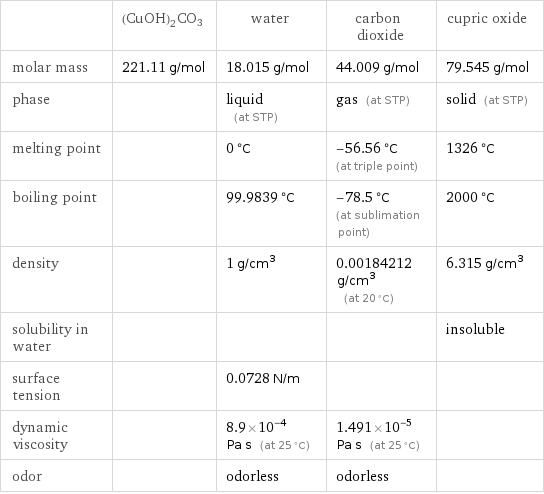Input interpretation

(CuOH)2CO3 ⟶ water + carbon dioxide + cupric oxide
Balanced equation

Balance the chemical equation algebraically: (CuOH)2CO3 ⟶ + + Add stoichiometric coefficients, c_i, to the reactants and products: c_1 (CuOH)2CO3 ⟶ c_2 + c_3 + c_4 Set the number of atoms in the reactants equal to the number of atoms in the products for Cu, O, H and C: Cu: | 2 c_1 = c_4 O: | 5 c_1 = c_2 + 2 c_3 + c_4 H: | 2 c_1 = 2 c_2 C: | c_1 = c_3 Since the coefficients are relative quantities and underdetermined, choose a coefficient to set arbitrarily. To keep the coefficients small, the arbitrary value is ordinarily one. For instance, set c_1 = 1 and solve the system of equations for the remaining coefficients: c_1 = 1 c_2 = 1 c_3 = 1 c_4 = 2 Substitute the coefficients into the chemical reaction to obtain the balanced equation: Answer: | | (CuOH)2CO3 ⟶ + + 2
Structures

(CuOH)2CO3 ⟶ + +
Names

(CuOH)2CO3 ⟶ water + carbon dioxide + cupric oxide
Chemical names and formulas

| (CuOH)2CO3 | water | carbon dioxide | cupric oxide formula | (CuOH)2CO3 | | | Hill formula | CH2Cu2O5 | H_2O | CO_2 | CuO name | | water | carbon dioxide | cupric oxide
Substance properties

| (CuOH)2CO3 | water | carbon dioxide | cupric oxide molar mass | 221.11 g/mol | 18.015 g/mol | 44.009 g/mol | 79.545 g/mol phase | | liquid (at STP) | gas (at STP) | solid (at STP) melting point | | 0 °C | -56.56 °C (at triple point) | 1326 °C boiling point | | 99.9839 °C | -78.5 °C (at sublimation point) | 2000 °C density | | 1 g/cm^3 | 0.00184212 g/cm^3 (at 20 °C) | 6.315 g/cm^3 solubility in water | | | | insoluble surface tension | | 0.0728 N/m | | dynamic viscosity | | 8.9×10^-4 Pa s (at 25 °C) | 1.491×10^-5 Pa s (at 25 °C) | odor | | odorless | odorless |
Units
